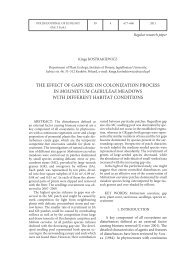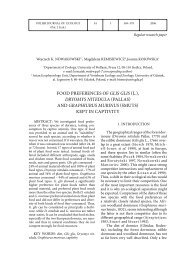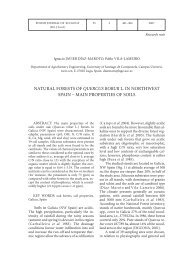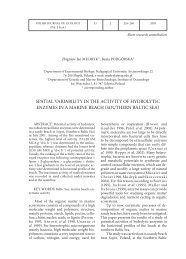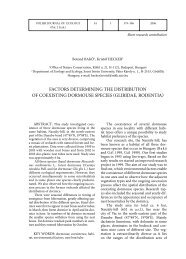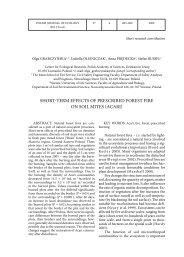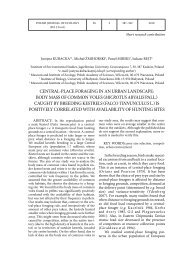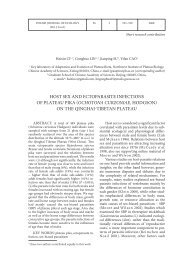phytoplankton of two river lakes in relation to flooding period
phytoplankton of two river lakes in relation to flooding period
phytoplankton of two river lakes in relation to flooding period
You also want an ePaper? Increase the reach of your titles
YUMPU automatically turns print PDFs into web optimized ePapers that Google loves.
POLISH JOURNAL OF ECOLOGY<br />
(Pol. J. Ecol.)<br />
53 3 419–425 2005<br />
Short research contribution<br />
Władysława WOJCIECHOWSKA 1 , Agnieszka PASZTALENIEC 1 , Michał SOLIS 1 ,<br />
Marek TURCZYŃSKI 2 , Jarosław DAWIDEK 2<br />
1<br />
Department <strong>of</strong> Botany and Hydrobiology, Catholic University <strong>of</strong> Lubl<strong>in</strong><br />
Norwida 4, 20-061 Lubl<strong>in</strong>, Poland, e-mail: sokol@kul.lubl<strong>in</strong>.pl<br />
2<br />
Department <strong>of</strong> Hydrography, Maria Curie-Skłodowska University<br />
Akademicka 19, 20-033 Lubl<strong>in</strong>, Poland<br />
PHYTOPLANKTON OF TWO RIVER LAKES IN RELATION TO<br />
FLOODING PERIOD (RIVER BUG, EASTERN POLAND)<br />
ABSTRACT: Studies were carry<strong>in</strong>g out <strong>in</strong><br />
<strong>two</strong> shallow (mean depth ≈ 0.3 m) and small<br />
(area 2.7–8.2 ha) <strong>river</strong> <strong>lakes</strong>, which were flooded<br />
by water <strong>of</strong> River Bug (Eastern Poland) once a year<br />
(<strong>in</strong> spr<strong>in</strong>g). The species composition, biomass <strong>of</strong><br />
<strong>phy<strong>to</strong>plank<strong>to</strong>n</strong> and concentration <strong>of</strong> chlorophyll<br />
a were studied. Samples were taken <strong>in</strong> June (after<br />
flood<strong>in</strong>g) and <strong>in</strong> August (after three months <strong>of</strong><br />
isolation from <strong>river</strong> water). About 150 species <strong>of</strong><br />
<strong>phy<strong>to</strong>plank<strong>to</strong>n</strong> were determ<strong>in</strong>ed. After the flood<br />
<strong>period</strong> <strong>phy<strong>to</strong>plank<strong>to</strong>n</strong> biomass was dom<strong>in</strong>ated<br />
by nannoplank<strong>to</strong>n belong<strong>in</strong>g <strong>to</strong> Cryp<strong>to</strong>phyceae<br />
and Chrysophyceae (strategy-r) and <strong>in</strong> the stabilization<br />
<strong>period</strong> by microplank<strong>to</strong>nic green and<br />
blue–green algae (strategy-K). The higher biomass<br />
and concentration <strong>of</strong> chlorophyll a values<br />
were noted <strong>in</strong> August than <strong>in</strong> June. The differentiation<br />
<strong>of</strong> <strong>phy<strong>to</strong>plank<strong>to</strong>n</strong> was also stated between<br />
near-by stations <strong>in</strong> both <strong>lakes</strong>.<br />
KEY WORDS: <strong>river</strong> <strong>lakes</strong>, floodpla<strong>in</strong> <strong>lakes</strong>,<br />
<strong>phy<strong>to</strong>plank<strong>to</strong>n</strong>, nannoplank<strong>to</strong>n, microplank<strong>to</strong>n,<br />
River Bug<br />
The valley <strong>of</strong> the River Bug (Eastern Poland)<br />
is considered as one <strong>of</strong> the last natural<br />
<strong>river</strong> valleys <strong>of</strong> Central Europe. The middle<br />
part <strong>of</strong> River Bug (Lubl<strong>in</strong> prov<strong>in</strong>ce) is unregulated<br />
and runs <strong>in</strong> a valley differ<strong>in</strong>g <strong>in</strong><br />
width. It meanders strongly <strong>in</strong> many places<br />
and tends <strong>to</strong> form the anas<strong>to</strong>mosis (Chmiel<br />
et al. 2003).<br />
The valley is rich with many riparian<br />
sites. Characteristic components <strong>of</strong> <strong>river</strong><br />
valley are <strong>river</strong> <strong>lakes</strong>, also called oxbow<br />
<strong>lakes</strong>, which are <strong>period</strong>ically flooded (usually<br />
<strong>in</strong> spr<strong>in</strong>g) by River Bug waters. Majority<br />
<strong>of</strong> <strong>river</strong> <strong>lakes</strong> <strong>in</strong> Europe is under human<br />
pressure and under strong eutrophication<br />
changes (flood<strong>in</strong>g by nutrient rich water<br />
<strong>of</strong> <strong>river</strong>, fish farm<strong>in</strong>g as well as us<strong>in</strong>g <strong>lakes</strong><br />
for <strong>to</strong>urism). The decrease <strong>of</strong> macrophyte<br />
density and decl<strong>in</strong>e the diversity <strong>of</strong> <strong>phy<strong>to</strong>plank<strong>to</strong>n</strong><br />
are the symp<strong>to</strong>ms <strong>of</strong> such changes<br />
(Van den Br<strong>in</strong>k et al. 1994, Amoros<br />
2001).<br />
The aim <strong>of</strong> the present study was <strong>to</strong> compare<br />
species composition and <strong>phy<strong>to</strong>plank<strong>to</strong>n</strong><br />
biomass <strong>in</strong> the <strong>period</strong> after the flood phase<br />
(<strong>in</strong>flow <strong>of</strong> Bug River waters <strong>to</strong> <strong>river</strong> <strong>lakes</strong>)<br />
and <strong>in</strong> the <strong>period</strong> <strong>of</strong> stabilization <strong>of</strong> conditions<br />
(isolation phase) <strong>in</strong> 2004 year.<br />
Studies were carried out <strong>in</strong> <strong>two</strong> <strong>river</strong><br />
<strong>lakes</strong> (Jama Roma and Orchówek) located<br />
<strong>in</strong> the middle part <strong>of</strong> the Bug Valley and distant<br />
from each other by 22 km. They belong<br />
<strong>to</strong> meander <strong>lakes</strong> (Chmiel et al. 2003) with<br />
mean depth ≈ 0.3 m, they are permanent water<br />
bodies, filled by water all over year. The
420 Władysława Wojciechowska et al.<br />
morphological parameters are presented <strong>in</strong><br />
Table 1 and bathymetry at Fig. 3.<br />
These <strong>lakes</strong> are supplied with water<br />
dur<strong>in</strong>g a short-last<strong>in</strong>g, spr<strong>in</strong>gtime flood<strong>in</strong>g<br />
by <strong>river</strong>, when the level <strong>of</strong> <strong>river</strong> water reaches<br />
220 cm (Fig. 1). The <strong>to</strong>tal exchange <strong>of</strong> water<br />
<strong>in</strong> <strong>lakes</strong> <strong>to</strong>ok 28 days. The first phase <strong>of</strong> the<br />
hydrological activity <strong>in</strong> <strong>river</strong> <strong>lakes</strong> (<strong>in</strong>flow<br />
and outflow) cont<strong>in</strong>ued s<strong>in</strong>ce 27 th <strong>of</strong> March<br />
until 14 th <strong>of</strong> April. The second phase, a weaker<br />
one, was characterizes only by outflow<strong>in</strong>g<br />
water from <strong>river</strong> <strong>lakes</strong> and it cont<strong>in</strong>ued from<br />
15 th until 23 rd <strong>of</strong> April (Fig.1). In the rema<strong>in</strong><strong>in</strong>g<br />
part <strong>of</strong> the year, <strong>lakes</strong> were supplied with<br />
water from their own catchment area.<br />
The catchment area <strong>of</strong> Lake Orchówek<br />
(124.8 ha) is managed and built-up (Fig. 2).<br />
The meadows and the farms are reach<strong>in</strong>g the<br />
<strong>river</strong>. In the lake itself, fish farm<strong>in</strong>g is performed.<br />
The catchment area <strong>of</strong> Lake Jama Roma<br />
(55 ha) has a more natural character; it is<br />
covered with p<strong>in</strong>e and alder trees (Fig. 2).<br />
Records <strong>of</strong> River Bug water levels from<br />
water-gauge <strong>of</strong> Institute <strong>of</strong> Meteorology and<br />
Water Management were used. Bathymetric<br />
maps were done <strong>in</strong> summer <strong>period</strong> by sonic<br />
depth f<strong>in</strong>der “Sonel” and measurements<br />
po<strong>in</strong>ts were localized by GPS with GARMIN<br />
apparatus.<br />
Biological and chemical studies (species<br />
composition and biomass <strong>of</strong> <strong>phy<strong>to</strong>plank<strong>to</strong>n</strong>,<br />
concentration <strong>of</strong> chlorophyll a, TN and<br />
TP) were conducted <strong>two</strong> times <strong>in</strong> 2004 year.<br />
One set <strong>of</strong> samples was taken <strong>in</strong> 1 th <strong>of</strong> June<br />
(the <strong>period</strong> after fill<strong>in</strong>g <strong>lakes</strong> by Bug waters)<br />
and a second one at 30 th August (after three<br />
months <strong>of</strong> isolation from <strong>river</strong> water, the <strong>period</strong><br />
<strong>of</strong> summer stabilization). In each <strong>of</strong> lake<br />
<strong>two</strong> stations were selected which differed <strong>in</strong><br />
a depth (Fig. 3). Samples were taken us<strong>in</strong>g<br />
Patalas-type water sampler and poured <strong>in</strong><strong>to</strong><br />
a collective sample from whole water column<br />
at each station.<br />
Total nitrogen and phosphorus (TN and<br />
TP) were analyzed by spectropho<strong>to</strong>metric<br />
methods after earlier m<strong>in</strong>eralization as described<br />
by Hermanowicz et al. (1999).<br />
The concentration <strong>of</strong> chlorophyll a was<br />
measured by a spectropho<strong>to</strong>metric method<br />
(Nusch 1980). Biomass was estimated based<br />
on the <strong>phy<strong>to</strong>plank<strong>to</strong>n</strong> number us<strong>in</strong>g an <strong>in</strong>verted<br />
microscope (by the way <strong>of</strong> Utermöhl)<br />
and mak<strong>in</strong>g the measurements <strong>of</strong> species<br />
sizes. The calculations were done accord<strong>in</strong>g<br />
<strong>to</strong> Hillebrand et al. (1999). The algae species<br />
were grouped <strong>in</strong> <strong>two</strong> size groups: nannoplank<strong>to</strong>n<br />
≤30 µm and microplank<strong>to</strong>n above<br />
30 µm accord<strong>in</strong>g <strong>to</strong> Pavoni (1963). The<br />
species diversity was estimated with Shannon-Weaver<br />
<strong>in</strong>dex (1949) and evenness<br />
<strong>in</strong>dex (Lloyd-Ghelardi 1964), accord<strong>in</strong>g<br />
<strong>to</strong> formulas:<br />
H' = ∑ – (n i<br />
/N • log n i<br />
/N)<br />
e = H'/H max ,<br />
where<br />
n i – numbers <strong>of</strong> a species i<br />
N – <strong>to</strong>tal numbers <strong>of</strong> <strong>phy<strong>to</strong>plank<strong>to</strong>n</strong><br />
H max = log 2<br />
S, S – number <strong>of</strong> species<br />
The physico-chemical parameters as SD,<br />
pH and conductivity were measured every<br />
time.<br />
In both <strong>lakes</strong> at stations where depth<br />
was greater than 3 m, the water transparency<br />
was lower <strong>in</strong> August (0.8 m) than <strong>in</strong> June<br />
(1.5 m).<br />
There was a difference <strong>in</strong> value <strong>of</strong> chemical<br />
parameters between <strong>lakes</strong>. The value <strong>of</strong><br />
water reaction and conductivity was greater<br />
<strong>in</strong> Lake Orchówek. In Lake Orchówek, the<br />
mean pH = 7.5, conductivity = 720 µS cm –1 ,<br />
while <strong>in</strong> Lake Jama Roma – pH = 6.5, conductivity<br />
= 550 µS cm –1 . The concentration <strong>of</strong> <strong>to</strong>tal<br />
phosphorus and <strong>to</strong>tal nitrogen were high<br />
<strong>in</strong> both <strong>lakes</strong>. In Lake Orchówek TP value<br />
was about 0.08 mg dm –3 , significant greater<br />
concentration <strong>of</strong> <strong>to</strong>tal phosphorus was noted<br />
<strong>in</strong> Lake Jama Roma – 0.20 mg dm –3 . Total ni-<br />
Table 1. Morphological parameters <strong>of</strong> studied <strong>lakes</strong>.<br />
Lake<br />
Area<br />
(ha)<br />
Volume<br />
(m 3 )<br />
Mean depth<br />
(m)<br />
Max. depth<br />
(m)<br />
Length <strong>of</strong><br />
shorel<strong>in</strong>e<br />
(m)<br />
Orchówek 8.17 27793 0.34 2.85 2618<br />
Jama Roma 2.68 8163 0.30 3.69 1481
Phy<strong>to</strong>plank<strong>to</strong>n <strong>of</strong> <strong>river</strong> <strong>lakes</strong> <strong>in</strong> <strong>relation</strong> <strong>to</strong> flood<strong>in</strong>g <strong>period</strong><br />
421<br />
A B A<br />
260<br />
240<br />
220<br />
Water level <strong>of</strong> River Bug [cm]<br />
200<br />
180<br />
160<br />
140<br />
120<br />
100<br />
80<br />
60<br />
Period <strong>of</strong> water exchange <strong>in</strong> <strong>lakes</strong><br />
03-11-01<br />
03-12-01<br />
04-01-01<br />
04-02-01<br />
04-03-01<br />
04-04-01<br />
04-05-01<br />
04-06-01<br />
04-07-01<br />
04-08-01<br />
04-09-01<br />
04-10-01<br />
Fig. 1. Changes <strong>of</strong> water level <strong>of</strong> River Bug <strong>in</strong> hydrological year 2004. A – isolation <strong>period</strong> (lack <strong>of</strong> contact<br />
<strong>of</strong> <strong>lakes</strong> with <strong>river</strong> waters), B – through-flow <strong>period</strong> (contact <strong>of</strong> <strong>lakes</strong> with <strong>river</strong> waters), Arrows<br />
<strong>in</strong>dicate a date <strong>of</strong> sampl<strong>in</strong>g.<br />
Fig. 2. Land use <strong>in</strong> the catchments <strong>of</strong> studied <strong>river</strong> <strong>lakes</strong>.
422 Władysława Wojciechowska et al.<br />
Fig. 3. Bathymetric maps <strong>of</strong> <strong>river</strong> <strong>lakes</strong> and location <strong>of</strong> sampl<strong>in</strong>g stations.<br />
%<br />
Lake Orchówek<br />
Lake Jama Roma<br />
June August June August<br />
100<br />
80<br />
60<br />
40<br />
20<br />
0<br />
1 2 1 2 1 2 1 2<br />
microplank<strong>to</strong>n<br />
nannoplank<strong>to</strong>n<br />
Fig. 4. The share <strong>of</strong> nanno- and microplank<strong>to</strong>n biomass <strong>in</strong> <strong>phy<strong>to</strong>plank<strong>to</strong>n</strong> at 1–2 stations <strong>of</strong> both <strong>lakes</strong>.
Phy<strong>to</strong>plank<strong>to</strong>n <strong>of</strong> <strong>river</strong> <strong>lakes</strong> <strong>in</strong> <strong>relation</strong> <strong>to</strong> flood<strong>in</strong>g <strong>period</strong><br />
423<br />
Table 2. Number <strong>of</strong> <strong>phy<strong>to</strong>plank<strong>to</strong>n</strong> species <strong>in</strong> studied <strong>lakes</strong>.<br />
Taxonomic group<br />
Number <strong>of</strong> species<br />
Lake Orchówek<br />
Lake Jama Roma<br />
Cyanoprokaryota 9 20<br />
Euglenophyta 0 7<br />
D<strong>in</strong>ophyceae 2 1<br />
Cryp<strong>to</strong>phyceae 4 6<br />
Chrysophyceae 0 9<br />
Bacillariophyceae 7 26<br />
Chlorophyta 41 23<br />
Table 3. Phy<strong>to</strong>plank<strong>to</strong>n parameters <strong>in</strong> studied <strong>lakes</strong> (mean values for station 1 and 2).<br />
Lake Orchówek<br />
Lake Jama Roma<br />
Parameters<br />
June August June August<br />
Chlorophyll a<br />
33 65 68 131<br />
(µg dm –3 )<br />
Phy<strong>to</strong>plank<strong>to</strong>n biomass<br />
(mg dm –3 )<br />
2 26 5 26<br />
Shannon-Weaver <strong>in</strong>dex (H’) 1.90 1.49 2.23 1.21<br />
Evenness <strong>in</strong>dex 0.54 0.39 0.56 0.30<br />
dom<strong>in</strong>ant species<br />
(percentage share <strong>of</strong> the species<br />
<strong>in</strong> <strong>to</strong>tal <strong>phy<strong>to</strong>plank<strong>to</strong>n</strong> biomass)<br />
Cryp<strong>to</strong>monas<br />
marssonii (37%)<br />
Chlamydomonas<br />
globosa (45%)<br />
Pandor<strong>in</strong>a<br />
morum (39%)<br />
Mallomonas<br />
semiglabra<br />
(28%)<br />
Mallomonas <strong>to</strong>nsurata<br />
(17%)<br />
Anabaena oscillarioides<br />
(53%)<br />
Microcystis<br />
flosque (33%)<br />
trogen content was similar <strong>in</strong> both <strong>lakes</strong> and<br />
reached about 2.50 mg dm –3 .<br />
In both <strong>lakes</strong> a <strong>to</strong>tal <strong>of</strong> 155 different species<br />
<strong>of</strong> plank<strong>to</strong>nic algae were determ<strong>in</strong>ed,<br />
which belong <strong>to</strong> seven various taxonomically<br />
groups (Table 2).<br />
The difference <strong>in</strong> composition and quantity<br />
<strong>of</strong> <strong>phy<strong>to</strong>plank<strong>to</strong>n</strong> between <strong>two</strong> studied<br />
<strong>period</strong>s was observed <strong>in</strong> both <strong>lakes</strong>. In the<br />
first <strong>period</strong> (after flood<strong>in</strong>g <strong>lakes</strong> by <strong>river</strong> water)<br />
the fast-grow<strong>in</strong>g and disturbance-<strong>to</strong>lerant<br />
nannoplank<strong>to</strong>nic species (r-strategists)<br />
had greater contribution <strong>to</strong> <strong>phy<strong>to</strong>plank<strong>to</strong>n</strong><br />
biomass (Fig. 4). The most <strong>of</strong> them belong<br />
<strong>to</strong> mixotrophic species (Reynolds 1984).<br />
Percentage share <strong>of</strong> nannoplank<strong>to</strong>n <strong>in</strong> <strong>to</strong>tal<br />
biomass was from 68 <strong>to</strong> 99% (Fig. 4). In Lake<br />
Orchówek, Cryp<strong>to</strong>phyceae was a dom<strong>in</strong>ate<br />
group and Chlorophyta was the second group<br />
characterized by great percentage share <strong>in</strong><br />
biomass (Fig. 5). In Lake Jama Roma Chrysophyceae<br />
dom<strong>in</strong>ated and Cyanoprokaryota<br />
species were the subdom<strong>in</strong>ants (Fig. 5). In<br />
mentioned above taxonomic groups usually<br />
<strong>two</strong> species were the most abundant, Cryp<strong>to</strong>monas<br />
marssonii and Rhodomonas pusilla<br />
(Cryp<strong>to</strong>phyceae), Mallomonas semiglabra<br />
and M. <strong>to</strong>nsurata (Chrysophyceae), Scenedesmus<br />
obliquus and Staurastrum sp. (Chlorophyta).<br />
Among Cyanoprokaryota the most<br />
numerous was a small (2.5 µm <strong>in</strong> diameter),<br />
<strong>two</strong>-celled species Synechocystis sp.<br />
Dur<strong>in</strong>g the isolation <strong>period</strong> the percentage<br />
share <strong>of</strong> microplank<strong>to</strong>n <strong>in</strong> <strong>to</strong>tal <strong>phy<strong>to</strong>plank<strong>to</strong>n</strong><br />
biomass significantly <strong>in</strong>creased <strong>in</strong><br />
both <strong>lakes</strong> (Fig. 4). Species belong<strong>in</strong>g <strong>to</strong> this<br />
size-group were composed with mixed morphotypes<br />
e.g. colonies or large unicells, all <strong>of</strong><br />
them are considered K-strategists (Reynolds<br />
1984). In Lake Orchówek microplank<strong>to</strong>n<br />
was dom<strong>in</strong>ated (40–50%) by <strong>two</strong> Chlorophyta<br />
species – Pandor<strong>in</strong>a morum and<br />
Closterium dianae. Despite microplank<strong>to</strong>n<br />
biomass <strong>in</strong>crease, the great contribution
424 Władysława Wojciechowska et al.<br />
Lake Orchówek<br />
Lake Jama Roma<br />
%<br />
June A ugust June A ugust<br />
100<br />
80<br />
60<br />
40<br />
20<br />
0<br />
1 2 1 2 1 2 1 2<br />
Cyanoprokaryota<br />
Chrysophyceae<br />
Others<br />
Cryp<strong>to</strong>phyceae<br />
Chlorophyta<br />
Fig. 5. The share <strong>of</strong> taxonomic groups <strong>in</strong> biomass <strong>of</strong> <strong>phy<strong>to</strong>plank<strong>to</strong>n</strong> at 1–2 stations <strong>of</strong> both <strong>lakes</strong>.<br />
(≥ 50%) <strong>of</strong> nannoplank<strong>to</strong>n was observed<br />
(Fig. 4). It was the result <strong>of</strong> the development<br />
<strong>of</strong> nannoplank<strong>to</strong>nic green alga – Chlamydomonas<br />
globosa. In Lake Jama Roma the microplank<strong>to</strong>n<br />
contribution <strong>in</strong> biomass was<br />
much greater (60–100%) and blue-green algae<br />
Anabaena oscillarioides and Microcystis<br />
flos-aquae were dom<strong>in</strong>ants (Table 3).<br />
In both <strong>lakes</strong> the species diversity expressed<br />
by Shannon-Weaver and evenness<br />
<strong>in</strong>dices was higher <strong>in</strong> June than <strong>in</strong> August<br />
(Table 3). The higher species richness after<br />
the <strong>river</strong> water flood<strong>in</strong>g <strong>in</strong> similar type <strong>of</strong><br />
<strong>lakes</strong> was observed also by Garcia de Emiliani<br />
(1993).<br />
The <strong>phy<strong>to</strong>plank<strong>to</strong>n</strong> abundance differs<br />
between both studied <strong>period</strong>s. Total<br />
biomass and chlorophyll a concentration<br />
were characterized by lower values <strong>in</strong> June<br />
(nannoplank<strong>to</strong>n dom<strong>in</strong>ance) than <strong>in</strong> August<br />
(microplank<strong>to</strong>n dom<strong>in</strong>ance) (Table 3).<br />
Total <strong>phy<strong>to</strong>plank<strong>to</strong>n</strong> biomass was <strong>in</strong> June<br />
2 mg dm –3 (L. Orchówek) and 5 mg dm –3<br />
(L. Jama Roma) and chlorophyll a concentration<br />
33 and 68 µg dm –3 respectively. In<br />
August <strong>phy<strong>to</strong>plank<strong>to</strong>n</strong> biomass <strong>in</strong> both <strong>lakes</strong><br />
reached the value (26 mg dm –3 ) many times<br />
higher and concentration <strong>of</strong> chlorophyll <strong>in</strong><br />
Lake Orchówek was as high as 65 µg dm –3<br />
and <strong>in</strong> Jama Roma – 131 µg dm –3 . The <strong>in</strong>crease<br />
<strong>of</strong> <strong>phy<strong>to</strong>plank<strong>to</strong>n</strong> biomass and greater<br />
percentage share <strong>of</strong> microplank<strong>to</strong>n <strong>in</strong> the<br />
isolation phase <strong>in</strong> shallow floodpla<strong>in</strong> <strong>lakes</strong><br />
was stated by other authors (Garcia de<br />
Emiliani 1993, de Oliveira and Calheiros<br />
2000).<br />
In both <strong>lakes</strong> <strong>phy<strong>to</strong>plank<strong>to</strong>n</strong> differed between<br />
studied stations (Fig. 5). In both <strong>lakes</strong><br />
the greater diversity <strong>of</strong> taxonomic groups<br />
occurred at station 1 and clear dom<strong>in</strong>ation<br />
by one taxonomic class was observed at station<br />
2 (Fig. 5). At station 2 <strong>in</strong> Lake Orchówek<br />
the contribution <strong>of</strong> Cryp<strong>to</strong>phycae (June) or<br />
Chlorophyta (August) <strong>to</strong> <strong>to</strong>tal biomass was<br />
higher than 90%, while <strong>in</strong> Lake Jama Roma<br />
<strong>phy<strong>to</strong>plank<strong>to</strong>n</strong> was dom<strong>in</strong>ated only by Cyanoprokaryota<br />
species (60–100%). The considerable<br />
differentiation between neighbor<strong>in</strong>g<br />
stations <strong>in</strong> the oxbow lake was noted<br />
by Wilk-Woźniak and Bucka (2004).
Phy<strong>to</strong>plank<strong>to</strong>n <strong>of</strong> <strong>river</strong> <strong>lakes</strong> <strong>in</strong> <strong>relation</strong> <strong>to</strong> flood<strong>in</strong>g <strong>period</strong><br />
425<br />
The studies <strong>of</strong> <strong>phy<strong>to</strong>plank<strong>to</strong>n</strong> confirmed<br />
that <strong>river</strong> <strong>lakes</strong> belong <strong>to</strong> water bodies<br />
<strong>in</strong> which the species diversity <strong>to</strong> a high<br />
degree depends on supply<strong>in</strong>g by <strong>river</strong> water.<br />
The through flow <strong>of</strong> <strong>river</strong> water results <strong>in</strong><br />
water mix<strong>in</strong>g <strong>in</strong> <strong>lakes</strong> and the <strong>in</strong>crease <strong>of</strong><br />
nutrients content (Amoros 2001). Accord<strong>in</strong>g<br />
<strong>to</strong> Reynolds (1984) these conditions<br />
favorite the development <strong>of</strong> small opportunistic<br />
r-selected species (like Cryp<strong>to</strong>phyceae<br />
and Chrysophyceae <strong>in</strong> studied <strong>river</strong><br />
<strong>lakes</strong>) characterized by rapid growth rate.<br />
In the <strong>period</strong> <strong>of</strong> summer stabilization (after<br />
three months isolation <strong>of</strong> <strong>lakes</strong> from the<br />
<strong>river</strong>) species with r-strategy were succeeded<br />
by large slow-grow<strong>in</strong>g forms <strong>of</strong> K-strategy<br />
(f.e. Pandor<strong>in</strong>a morum or Microcystis<br />
flos-aquae).<br />
ACKNOWLEDGMENTS: This work was supported<br />
by the Polish State Committee for Scientific<br />
Research (KBN grant 2 P04F 027 26).<br />
REFERENCES<br />
Amoros C. 2001 – The concept <strong>of</strong> habitat diversity<br />
between and with<strong>in</strong> ecosystems applied<br />
<strong>to</strong> <strong>river</strong> sidearm res<strong>to</strong>ration – Environ.<br />
Manag. 28: 805–817.<br />
Chmiel S., Dawidek J., Szwajgier W.,<br />
Turczyński M. 2003 – Genetic types and<br />
transformations <strong>of</strong> <strong>lakes</strong> <strong>in</strong> the Middle Bug<br />
valley-floor – Limnol. Rev. 3: 31–36.<br />
De Olivera M. D., Calheiros D. F. 2000 –<br />
Flood pulse <strong>in</strong>fluence on <strong>phy<strong>to</strong>plank<strong>to</strong>n</strong> communities<br />
<strong>of</strong> the south Pantanal floodpla<strong>in</strong>,<br />
Brazil – Hydrobiologia, 427: 101–112.<br />
Garcia de Emiliani M. O. 1993 – Seasonal<br />
succession <strong>of</strong> <strong>phy<strong>to</strong>plank<strong>to</strong>n</strong> <strong>in</strong> a lake <strong>of</strong> the<br />
Paraná River floodpla<strong>in</strong>, Argent<strong>in</strong>a – Hydrobiologia,<br />
264: 101–114.<br />
Hermanowicz W., Dojlido J., Dożańska<br />
W., Koziorowski B., Z erbe J. 1999 – Fizyczno–chemiczne<br />
badanie wody i ścieków<br />
[Physico-chemical <strong>in</strong>vestigation <strong>of</strong> sewage<br />
and water] – Arkady, Warszawa. (<strong>in</strong> Polish).<br />
Hillebrand H., Dürselen C.-D., Kirschtel<br />
D., Poll<strong>in</strong>gher U., Z ahar y T. 1999<br />
– Biovolume calculation for pelagic and benthic<br />
microalgae – J. Phycol. 35: 403–424.<br />
Lloyd M. R ., Ghelardi J. 1964 – A table<br />
for calculat<strong>in</strong>g the “equitability” component<br />
<strong>of</strong> species diversity – J. Anim. Ecol. 33:<br />
217–225.<br />
Nusch E. A. 1980 – Comparison <strong>of</strong> different<br />
methods for chlorophyll and pheopigment determ<strong>in</strong>ation<br />
– Arch. Hydrobiol. Beih. Ergebn.<br />
Limnol. 14: 14–36.<br />
Pavoni M. 1963 – Die Bedeutung des Nannoplank<strong>to</strong>ns<br />
im Vergleich zum Netzplank<strong>to</strong>n<br />
– Schweizerische Zeitschrift für Hydrologie,<br />
25: 219–341.<br />
Reynolds C. S. 1984 – The ecology <strong>of</strong> freshwater<br />
<strong>phy<strong>to</strong>plank<strong>to</strong>n</strong> – Cambridge University<br />
Press, Cambridge, London, New York, New<br />
Rochelle, Melbourne, Sydney.<br />
Shannon C. E., Weaver W. 1949 – The mathematical<br />
theory <strong>of</strong> communication – University<br />
<strong>of</strong> Ill<strong>in</strong>ois Press, Urbana IL, 117 pp.<br />
Van den Br<strong>in</strong>k F.W.B., Van Katwijk M.<br />
M., Van der Velde G. 1994 – Impact <strong>of</strong><br />
hydrology on phy<strong>to</strong>- and zooplank<strong>to</strong>n community<br />
composition <strong>in</strong> floodpla<strong>in</strong> <strong>lakes</strong> along<br />
the Lower Rh<strong>in</strong>e and Meuse – J. Plank<strong>to</strong>n Res.<br />
16: 351–373.<br />
Wilk-Woźniak E., Bucka H. 2004 – Flora<br />
glonów w rezerwacie wodnym Wiślisko<br />
Kobyle – starorzecze rzeki Wisły (Puszcza<br />
Niepołomicka, okolice Krakowa) [Algae <strong>in</strong><br />
the oxbow-lake – Wiślisko Kobyle, protected<br />
area <strong>in</strong> the Niepołomice Forest (Kraków)] –<br />
Mat. Konf. 53 Zjazdu PTB, Toruń-Bydgoszcz,<br />
pp. 55. (<strong>in</strong> Polish).<br />
(Received after revis<strong>in</strong>g March 2005)




